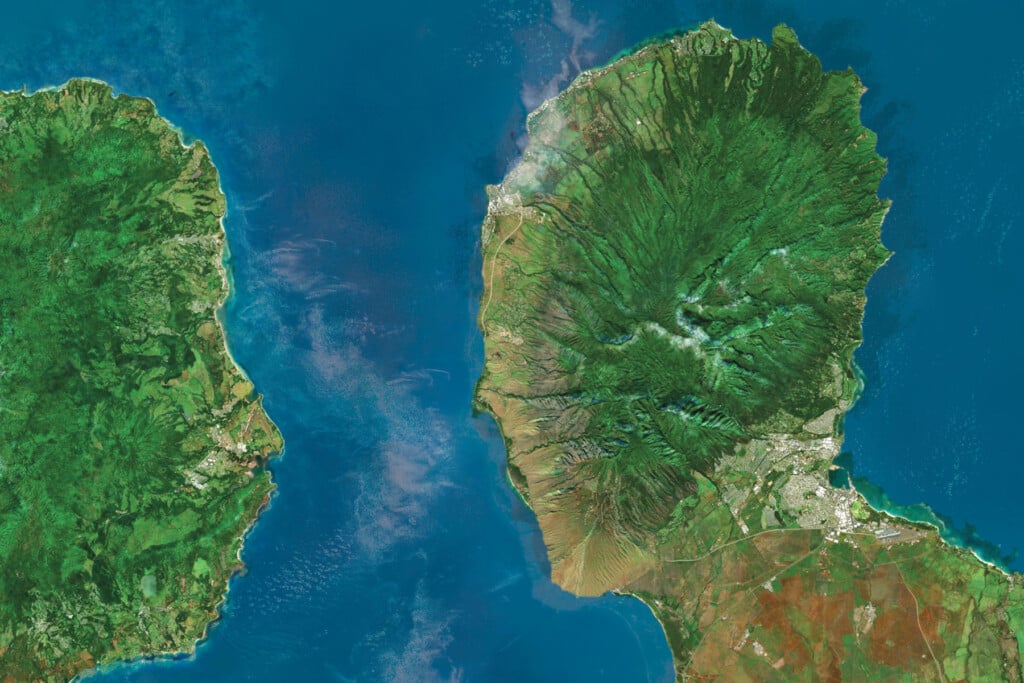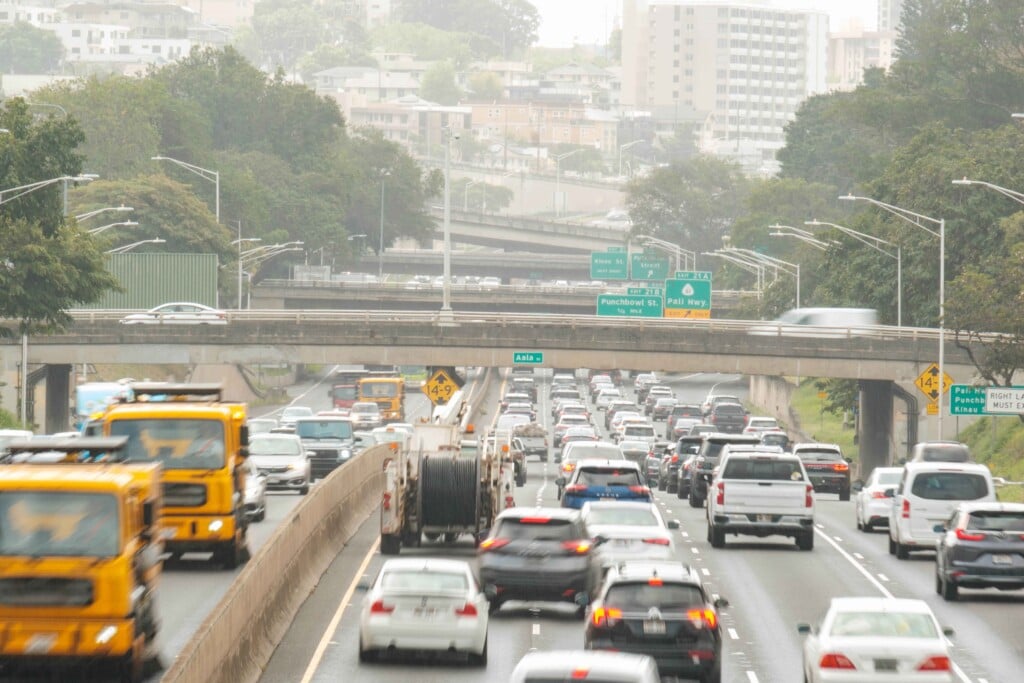Affordable Walk-up Apartments Are Coming Back, Thanks to Honolulu’s Bill 7
Small landowners and developers can use exemptions and waivers to build new multistory rentals on small residential lots – and help ease the housing squeeze.

A five-story walk-up with 25 affordable rental units is being built on a 5,000-square-foot lot in Liliha, the former site of an abandoned single-family home built in the 1940s.
The new building at 311 Puuhue Place is the first project constructed under Honolulu’s Bill 7. The bill provides exemptions and fee waivers from standard building regulations to encourage the development of affordable rentals on small, underused lots already zoned for multifamily dwellings.
As of Jan. 10, 2022, 17 applications for building permits and fee waivers under Bill 7 had been submitted, for a total of 467 affordable rental units, according to Honolulu’s Department of Planning and Permitting. Three projects have been fully approved.
“It’s just a great opportunity,” says Derek Lock, a principal and co-owner of HNL Development. Lock redeveloped the lot at 311 Puuhue with partners Jason Nishikawa and Keslie Hui. “And there’s not a lot of cities that up-zone the land, but this was a very genius piece of legislation that can increase our housing and help with the affordable housing costs.
“It’s kind of out of the box.”
Incentivizing Development
Various types of low-rise apartments already exist in such areas as Makiki, Kapahulu, Mō‘ili‘ili and McCully. Many were built in the 1960s and ’70s and their simple designs often consist of concrete masonry blocks and basic windows.
New versions of those buildings are few and far between as current building and zoning codes make it difficult for developers to make a profit while building affordable rental projects, says Mel Kaneshige, a retired real estate attorney who helped draft Bill 7, the Affordable Rental Housing Bill. It’s often more profitable to build for-sale condos, he says, but that leaves out affordable rentals, for many the first step on the housing ladder.
“There was a period in time when the shortage was being fulfilled with private development, and the question that we asked ourselves is why can’t that happen again,” says Newton Chung, a retired construction consultant who worked on the bill with Kaneshige and retired affordable housing developer Marshall Hung.
Act 127, passed in 2016 by the state Legislature, set a goal to develop 22,500 affordable rental units across the Islands by 2026. Those units need to target people whose incomes are below 140% of the area median income. In Honolulu, that’s up to an annual income of $169,000 for a family of four.
Build Taller, Wider and Denser
Honolulu’s Bill 7, which expires in 2024, makes the construction of affordable rentals cheaper by allowing developers and landowners to build taller, wider and denser than normally allowed in areas that have apartment, apartment mixed-use and business mixed-use zoning.
These buildings, which can rise up to 60 feet, can only be constructed on lots of 20,000 square feet or less. They are not required to have off-street parking, elevators or loading zones, though a developer could include them.
At least 80% of the units in these buildings must be rented to households earning up to 100% of the area median income – about $120,800 for a family of four. And the rents must be at or below the rental limits set by the U.S. Department of Housing and Urban Development for that income group and stay affordable for 15 years.
“This was a very genius piece of legislation that can increase our housing and help with the affordable housing costs.”
– Derek Lock, principal and co-owner of HNL Development
Bill 7 projects receive waivers on building permit and wastewater system facility fees plus some property tax exemptions. The county permitting department is required to approve or disapprove Bill 7 building permit applications within 90 days.
Kaneshige says these projects are meant to be privately financed without government subsidies, so the bill was designed to keep construction costs low.
“If you can keep that per square-foot cost down, then obviously your total development cost is down and then you can rent out your units at a lower amount and still make money,” he says.
In 2021, Honolulu Mayor Rick Blangiardi signed into law Bill 1, which created a $10 million grant program to further encourage the construction of affordable rentals during the Covid pandemic. The grant program will end at the same time as Bill 7 in 2024. Affordable rental project owners can receive $11.25 per square foot of dwelling floor area – up to $9,000 per dwelling unit – when their units are rented to households earning between 61% and 100% of the area median income. When units are rented to households earning 60% and below of the area median income, the amount is $15 per square foot – up to $15,000 per unit.
More Options for Landowners
Honolulu’s Department of Planning and Permitting wrote in a 2018 report that 3,200 apartment-zoned lots between 5,000 and 20,000 square feet could be eligible for redevelopment under Bill 7. About 1,400 of those are considered good candidates for redevelopment because the value of improvement on those lots would likely cost 30% or less of the land value, the department wrote, and could result in up to 21,000 new units. That estimate assumes the building on each lot would have four floors and units would average 800 gross square feet.
The potential for additional units is even greater when apartment mixed-use and business-mixed use lands are included, the department wrote, but it did not do that calculation.
Many small lots have been passed down through families, Kaneshige says. Some have aging houses, but there’s little incentive for families to make repairs or improvements.
If the lots are empty, the building code limits what can be built, Chung adds. For example, a family might only be able to build a duplex with four units on a 5,000-square-foot lot. Bill 7 allows that lot size to have up to 25 units.
“A lot of those properties are stuck in the mud, and they’re not going to get renovated and they’re not going to get torn down or redeveloped unless there was some other kind of incentive,” Kaneshige says, adding that the incentive would be more units that could produce enough rent to cover the cost of construction and provide for the family’s next generation.
The families could also partner with a developer if they don’t want to redevelop properties on their own. Lock says over the last 2 ½ years, HNL Development, its architects and banks have talked with 25 groups about building on their families’ properties. Two families have since contracted HNL Development; those projects are going through the Bill 7 permit process.
“In a way, the land can stay in the family for generations, and in a way, it’s a win-win for both the landowners and the community,” Lock says.
Bill 7 can also be an answer to monster homes being built in single-family residential neighborhoods by encouraging their development in appropriately zoned areas that already have the sewer, water, electric and transportation infrastructure necessary for multifamily housing, he adds.
More in the Pipeline
The project at 311 Puuhue consists of a wood-framed building covered in cement board. The 25 one-bedroom, one-bath units are accessible by two stairwells and open corridors. A concrete garage provides bicycle and moped parking, plus 11 parking stalls. Kuakini Medical Center, a Foodland store and several eateries are within walking distance. Bus stops and the H-1 are also nearby.
HNL Development plans to finish construction in February and accept applications from potential renters in March. Rent for each of the 460-square-foot units will start at $1,200 a month, which is considered affordable for those who earn less than 80% of the area median income.
Lock says the project is likely the first new multifamily walk-up built in Honolulu in a long time and the team, which included architect Interlock LLC and contractor IC Construction, had to make sacrifices to keep the project affordable. Construction costs are estimated to be $290 per square foot.
It’s hard to directly compare its cost to other projects, he says, but the 801 South Street workforce housing project he worked on with Hung, the retired developer, cost about $300 per square foot for 1,000 units. High-rise condos, he says, can achieve economies of scale that low-rise buildings can’t.
While the Puuhue project needed all of Bill 7’s exemptions, the lack of a parking requirement helped the most, Lock and Nishikawa say. Normally, one parking stall would be required for each multifamily unit and the project has only 11 stalls and 25 units.
The three owners of HNL Development were mentored under Hung and have taken up his mission to help house the local community. They have two more Bill 7 projects in the pipeline. One will turn a 17,000-square-foot Wahiawā parcel with five single-family homes built in the 1930s into a 36-unit walk-up. The other will turn an empty 5,000-square-foot lot in McCully into a 25-unit walk-up.
Lock says his team can now reuse the design at 311 Puuhue, and apply lessons learned from its work there, on future projects.
“We can really sort of rinse and repeat and achieve some sort of economies of scale and just keep building as long as we can,” he says.






